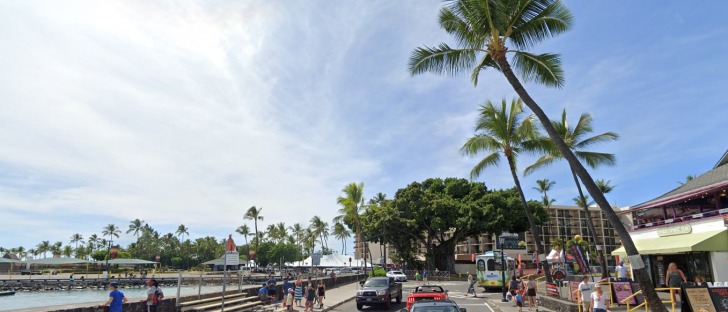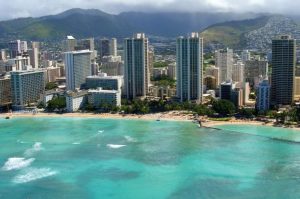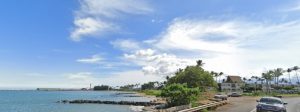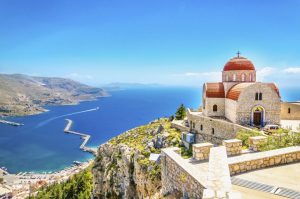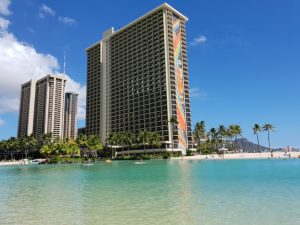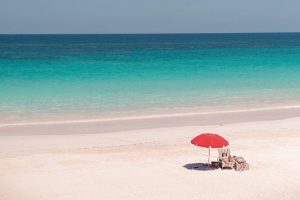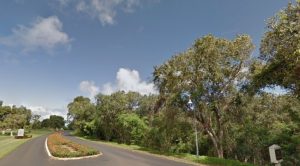Kailua-Kona is one of many names for this city on the “Big Island” of Hawaii.
While some refer to it as Kailua, that might confuse a tourist because there’s also a Kailua district in Honolulu, which is on the island of Oahu.
Kailua-Kona sits on the western edge of the island and is home to nearly 20,000 people.
While it’s a popular resort region, it won’t have the same intensity of crowds as the island of Oahu.
Before we dive in, let’s get on the same page.
This is not an all-encompassing guide to the Hawaiian islands, amenities, attractions, and itineraries.
It’s so easy to get overloaded with information about a Hawaiian getaway.
We are going to stay hyper-focused on SAFETY.
Why do I punctuate that point?
Because I’ve been researching this for an hour and almost booked a flight twice.
We’ll stay in our safety lane offering legitimate safety advice from vetted sources as there is some really wacky safety advice out there.
No, this won’t be the most fun article about Kailua-Kona or Hawaii, but it will be informative with a few surprises along the way.
When you think of Hawaii, a certain image will come to your mind.
It might be the beach.
It might be walking on the edge of an active volcano.
It might be eating pig from an imu (underground oven).
Hawaii is filled with so many microclimates it’s hard to summarize all of them, so we’ll stay on task with the safety advice for Kailua-Kona.
The city is nestled perfectly between two districts and near the Kona International Airport (not the Honolulu Airport).
This is a great place to stay if you’ll spend a lot of time exploring the western side of the Big Island.
The main street in Kailua-Kona is Aliʻi Drive.
This nearly seven-mile stretch is home to everything a tourist could want, from shopping to dining to historic adventures.
Warnings & Dangers in Kailua-Kona

OVERALL RISK: LOW
There is a low risk here, but as with any Hawaiian tourist area, there are inherent risks of crime and natural hazards. It's a delicate balance of following the safety advice and exploring your wild side.

TRANSPORT & TAXIS RISK: LOW
Don't let the name "Big Island" fool you, it's still just 95 miles wide. It's just much bigger than other islands. That means there are plenty of ways to get around. Renting a car is a great idea if you want control of your sightseeing adventures, but obviously, you leave the car behind if you go to another island. Also, check the fine print because there are some locations where car rental places won't let you take the car, like the Green Sand Beach. This is due to the dangerous roads along the way and most require a 4X4 vehicle anyway. There are taxis, rideshares, and a public bus system. Sightseeing tours are another great way to get around without having to worry about driving, but you'll be locked into that one sightseeing location. There's a low risk of using any option, but public transportation isn't as frequent or viable as it is on the larger island of Oahu.

PICKPOCKETS RISK: LOW
There's a low risk by the numbers, but there's ALWAYS going to be a risk when you are in a big tourist area like this. Ideally, bring a backpack with your most valuable items tucked deep inside the pack, not on the easy-to-open zipper area. Only bring what you absolutely need for that day. Don't store all your cash in one place to avoid having to pull out a wad of cash in public.

NATURAL DISASTERS RISK: LOW
There's low risk on an average day, but the risks that do exist are huge, if not catastrophic. Tsunamis, volcano eruptions, flash flooding, and hurricanes are the biggest risks. Let's not forget in 2018 when a mistaken incoming nuclear missile warning went out across the islands. It's a great idea when studying all the tours in Hawaii to set aside some time for how to handle emergencies through the Department of Emergency Management website.

MUGGING RISK: LOW
There's a low risk IF you stay in the tourist areas and follow the safety advice. The concierge at your hotel is going to be the best advisor for this. You don't want to always stay in the tourist areas, right? You also don't want to visit a village with an incredibly high violent crime right. Unless you are going into the wilderness, it's best to stay near a tourist area during the daytime. Walking around at night, either on the beach or in less populated areas, could be dangerous.

TERRORISM RISK: MEDIUM
The tragic remains of the Pearl Harbor attack so just how much of a risk this location can be. While it's in the middle of the ocean, far away from any mainland, it's also home to U.S. Military installations that guard the Pacific Ocean and keep enemies at bay. It's always going to be considered a target with medium risk.

SCAMS RISK: MEDIUM
There's a medium risk of being scammed if you don't ask questions and be cynical every step of the way. I cannot tell you the overwhelming amount of information I dug up on Kailua-Kona from suspicious-looking websites. One was so shady I immediately ran a virus scan on my computer. While we all want a good deal on our travel, don't go into this looking for a good deal at any cost. Only go through reputable websites. Never wire money ahead of time to hold a hotel room or home rental. Even when you Google items, look for the green checkmark next to the title to make sure the website is safe to visit. Then there's a whole new layer of scam concerns when you arrive. I can tell you this - the prices across all the Hawaiian islands are going to make you feel like you're getting scammed. The prices are going to be much higher because of the distance goods have to travel to get to Hawaii. Milk costs more than $6 a gallon. You can't get a loaf of bread for less than $5. That cost is going to be parlayed into the restaurants you visit.

WOMEN TRAVELERS RISK: LOW
There's a low risk for women during the daytime and the risk goes up slightly at night, especially if the woman is wandering around alone. It's best to explore a little at a time so you can get used to the peddlers, other tourist interactions, and intricacies of each location. Basic safety practices will go a long way here.

TAP WATER RISK: LOW
There are a lot of different wells the water comes from in this region. We've included a link below so you can check the water quality closer to your time of visit. One of the biggest complaints about the tap water from tourists is the taste. Bottled water is readily available and you can also go to the local Walmart and get gallons of water that have been filtered even more.
Safest Places to Visit in Kailua-Kona
If you like to start the day with a walk or a run, check out Maka’eo Walking Path.
There is a wonderful display of wildlife, flowers, and plants along the way.
You might see homeless people along this path, so it’s smart to pay attention to your surroundings on your stroll.
The center focal point of Kailua-Kona is Ali’i Drive.
While it’s not as bustling of a market as you’d find in Honolulu, it’s the best shopping in this area for souvenirs.
It’s wise to bring sunscreen and aloe vera gel with you so you don’t have to pay the high prices for it on the island.
Kamakahonu Beach is a safe place for the whole family if you’re bringing kids.
You won’t deal with errant waves here and it’s a perfect place for snorkeling.
You can also wander along the nearby pier.
There’s a night dive that is considered one of the top attractions in all of Kailua-Kona.
It’s a Manta Ray dive (or snorkel).
An experienced tour guide will take you to a place most likely to see Manta Rays.
While they are related to their meaner cousin “Stingray”, these rays don’t have a stinger and can’t hurt you.
If you want to do the full dive, you’ll need to get scuba certified before you go.
For some pre-historic education, check out the Waikoloa Petroglyph Preserve.
This is an easy walk and there are educational kiosks along the way.
Places to Avoid in Kailua-Kona
This is an area that is rapidly growing and has been for quite some time.
It wasn’t too long ago this was just a quiet fishing village.
The dangerous areas of town can change frequently.
Crime maps show the area north of the pier is the most dangerous area when totaling the crime statistics.
Once you pass the Kohanaiki community, the crime rates go down.
You’re going to rely heavily on that concierge we talked about earlier to get good safety advice.
It’s important to remember a lot of the people who work here live off of tips.
If you get information from a concierge, be sure to tip a few bucks.
I have always been a big fan of tipping ahead of time.
For example, giving the concierge $100 when I arrive.
However, there’s always a risk that a person won’t end up being very helpful.
It’s worked out for me more often than not, and it was fewer times I had to pull cash out of the wallet.
I also found they were a little more invested in my safety when they knew off the bat I was a good tipper.
For excellent service, I’d give another tip on the day of departure.
You are going to meet a lot of people while you’re here and not all of them will be tourists.
When someone asks you where you live, do NOT say “I live in America.”
Hawaii IS one of the United States.
The preferred answer is “I live on the mainland.
In Chicago/Toledo/Portland.”
Hawaiians are very sensitive when people don’t consider their state part of America.
Safety Tips for Traveling to Kailua-Kona
*Note:
There is no way just 10 tips are going to encompass all of the safety advice for Hawaii.
I’ve listed 10 that I feel are the most important, but you should do advanced research on safety before your trip.
- Sign up for Nixle emergency alerts before you arrive. You can do this through the Hawaii Police Department. The police here serve the entire island of Hawaii, aka “The Big Island.” Then you’ll get weather, civil, and criminal emergency information on your mobile device.
- You need to have daily weather reports be part of your breakfast routine. You need the weather report for each area you’ll be visiting that day (welcome to microclimates!), the surf report for your chosen beach(es), and ocean water quality reports. Any one of these elements can quickly cause you to change plans for the day.
- Never Turn Your Back on the Ocean. This is a message you’ll be inundated with when you reach Hawaii. Rouge waves, strong rip currents, dangerous marine wildlife, and many other issues can come with the waves. Even when taking pictures at the beach, make sure someone in your party is keeping an eye on the ocean.
- Look at the hazard warnings on the beach each day. They are different than some of the mainland beaches with a flag system. A yellow square means “Caution” and is the lowest risk beach area. A red stop sign outline means there is a high hazard and people should avoid the water. A black diamond means extreme hazards are present and you should avoid the water. A stop sign outline with a white line through it means the beach is closed.
- You will need to have reef shoes when going into the ocean near any kind of rock. Not only can any human interaction with a coral reef cause severe damage to the ecosystem, but it can also be quite painful when humans are cut by the sharp reefs. Reef shoes, also known as water shoes, are very lightweight socks but have a rubber bottom protecting the foot.
- Only swim during strong daylight hours. Avoid night swimming, or going in the water around dawn or dusk. That’s prime shark feeding time. It’s also a time of day when there aren’t lifeguards at the beaches. On average there are about a dozen shark attacks in Hawaii each year.
- Never go in the water you can’t see through. Not only are there dangers like sharks, jellyfish, and man-o-wars in the water, a Brown Water Advisory means there is an algae or bacterial presence in the water. This is generally caused by rain runoff.
- Don’t go hiking with rain in the forecast. Even the public trails in this area are prone to flash flooding that can easily wipe you off your feet and the rushing water can contain dangerous rocks and tree limbs.
- Never hike alone or go outside the marked trail. Private or dangerous areas are marked clearly with No Tresspassing signs. Hiking alone is very dangerous as the beauty of the area is second only to the potential dangers of slipping and falling. I live in Nebraska right now and there’s an ongoing story of a local college student who went to Hawaii alone for camping and hiking over a two-week span and hasn’t been seen since May of 2021. His backpack was found, but no sign of him after exhaustive searches.
- No matter how thirsty you get, don’t drink from the streams or waterfalls along your Hawaiian journey. There’s a bacteria in Hawaii streams that can cause Leptospirosis. This can cause a flu-like sickness that will ruin your vacation. Bring plenty of clean water with you realizing you are going to sweat a lot and should need twice as much water as you think is necessary. At least one gallon of water per person is recommended.
So... How Safe Is Kailua-Kona Really?
Hawaii relies so much on tourism revenue that it can’t afford to NOT be safe in all of its tourist areas and cruise port locations.
Getting exact data is challenging here because the city of Kailua-Kona is part of the Hawaii Police Department coverage area.
The data available is just for the entire island.
On the Big Island as a whole, there’s a one in 383 chance of being a victim of violent crime.
That’s slightly above the Hawaiian state average.
Property crime here is actually lower than the state average.
There’s a one in 58 chance of being a victim of a property crime.
If you have a car while you’re here, you need to use it as a way to get back and forth and nothing more.
Don’t load up a bunch of gear and then leave it in the car.
There are a lot of car break-ins on this island, and all the others.
Never pack up the trunk in a public place as thieves can then see where all the valuables are.
Being safe in Kailua-Kona is as much about avoiding being a victim of a crime as it is being a victim of the environment.
There is so much beauty to see here, but there are dangers even for people who think they are strong swimmers or advanced hikers.
It’s just a very unique climate that should be respected and studied before you visit.
How Does Kailua-Kona Compare?
| City | Safety Index |
|---|---|
| Kailua-Kona | 84 |
| New Orleans | 57 |
| Baltimore | 56 |
| Boston | 67 |
| Washington DC | 56 |
| New York City | 67 |
| Detroit | 56 |
| Niagara Falls (Canada) | 87 |
| Calgary (Canada) | 82 |
| Buenos Aires (Argentina) | 60 |
| Vancouver (Canada) | 82 |
| Cordoba (Argentina) | 61 |
| Toronto (Canada) | 81 |
Useful Information

Visas
You do not need a Visa if you are American, because this is just like visiting any other state. For non-Americans, you'll provide the Visa when you arrive at the airport and go through Customs. Both Border Patrol and Homeland Security will check your Visa and make a decision if you can enter the U.S.

Currency
The U.S. Dollar is used here exclusively. There are fewer all-inclusive resorts than there used to be in an effort to get more tourists to visit different locations and not just stay locked at one resort. Never pull out a large stash of cash in public and be very protective of opening your wallet or entering the PIN when making purchases.

Weather
The coldest day here isn't going to get below 80°(F). Most of the seasonal changes don't happen in the temperatures but in the movement of the ocean or the amount of rainfall. You'll need rain gear, strong hiking boots, sunscreen, bug spray, and long-sleeved shirts and pants that are lightweight so you can avoid bugs and branches when hiking.

Airports
There is an international airport on the island of Hawaii that has mainland flights. The busier airport is the one in Honolulu. If you fly into HNL, you'll have to take a separate flight to get to the Big Island.

Travel Insurance
You'll want travel insurance for a trip to Hawaii because there are just so many risks and variables. Be sure you are clear about what kinds of injuries or accidents are covered and make sure missing luggage is on the list of covered issues.
Kailua-Kona Weather Averages (Temperatures)
Average High/Low Temperature
| Temperature / Month | Jan | Feb | Mar | Apr | May | Jun | Jul | Aug | Sep | Oct | Nov | Dec |
|---|---|---|---|---|---|---|---|---|---|---|---|---|
| High °C | 27 | 27 | 28 | 28 | 29 | 30 | 30 | 31 | 31 | 30 | 29 | 28 |
| Low °C | 19 | 19 | 20 | 21 | 21 | 22 | 23 | 23 | 23 | 22 | 21 | 20 |
| High °F | 81 | 81 | 82 | 82 | 84 | 86 | 86 | 88 | 88 | 86 | 84 | 82 |
| Low °F | 66 | 66 | 68 | 70 | 70 | 72 | 73 | 73 | 73 | 72 | 70 | 68 |
Hawaii - Safety by City
| City | Safety Index |
|---|---|
| Hilo | 65 |
| Honolulu | 65 |
| Kailua-Kona | 84 |
| Lanai City | 89 |
| Maui | 91 |
| Princeville | 88 |
